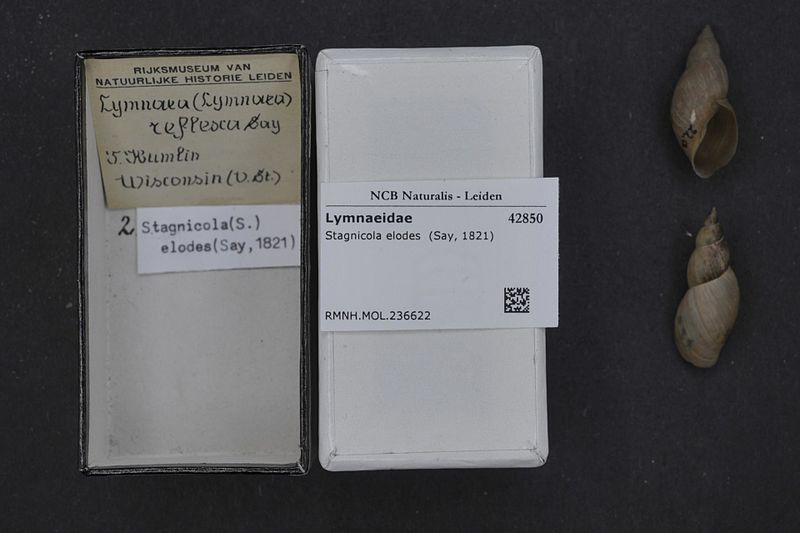 |
| Pomatiopsis lapidaria by John Slapcinsky under CreativeCommons CC BY-NC-SA 3.0 via boldsystems.org |
 |
| Pomatiopsis lapidaria by Smithsonian Institution NMNH, under CreativeCommons CC BY-NC-SA 3.0 via eol.org |
It is interesting to note that P. lapidaria are said to have a characteristic "loping" movement, which involves large arching waves of motion that results in unusually rapid progression. This seems to be a characteristic of other land snails as well. Additionally, these are amphibious snails, and controversies have raged in the past about their terrestrial/aquatic habitat preferences. The species also seems to be nocturnal in its habits, hiding under leaves on bright days and being active on warm humid evenings in areas with moist marshy soils. They are also able to withstand long periods of dessication and are capable of being laboratory reared for experimental purposes.
As a veterinary parasitologist, I find it incredibly important to understand the vectorial capacity of this snail. These are several mentions of experiments from the world war II era in which attempts were made to determine if P. lapidaria was a vector of Schistosoma japonicum (the "Oriental" blood fluke). The basis for these experiments stemmed from the ecological and morphological similarity of P. lapidaria to Oncomelania, another member of the Pomatiopsidae, found in east Asia, which is known to be a competent vector of S. japonicum. However, it was found that only 5 out of 2000 experimentally infected P. lapidaria could shed S. japonicum cercaria, making the snail a poorly adapted vector. However, the snail is intermediate host extraordinaire for Paragonimus kellicotti, Nudocotyle novicia (a bile duct fluke of meadow mice) and Euhryhelmis monorchis (a mink trematode).
From a public health perspective, it is important to note that Paragonimus kellicotti is an endemic trematodiasis that can affect humans in North America who consume raw or undercooked crayfish containing the infective metacercaria of the fluke. While the trematode can complete its life-cycle in humans resulting in patent infections, ectopic migration can cause trematode larval migrans (when the flukes migrate in subcutaneous tissues) and cerebral paragonimiasis, which are both rare in dogs, cats and other animals. The second intermediate hosts are crustaceans (crayfish) of the genera Oronectes and Cambarus, in which the metacercaria have a predilection for the crustacean heart. Humans infections have been reviewed in a fantastic paper by Diaz J. in the journal Clinical microbiology reviews (Link here).
References:
Title reference: The title of this post is a play on the common name of the snail (Slender walkers) and their ability to move by loping, which is a motion almost as unique as the dance move called "moon-walk" of wide pop-cultural fame. The snails are also nocturnal, which helps with the moon walking theme.
Say, Thomas. Description of Seven Species of American Frech-water and Land Shells, Not Noticed in the Systems. 1817.
Dundee, Dee Saunders. "Aspects of the biology of Pomatiopsis lapidaria (Say)(Mollusca: Gastropoda: Prosobranchia)." (1957).
Parker, George Howard. "The loping of land-snails." The Biological Bulletin 72.3 (1937): 287-289.
Ameel, Donald J. "Observations on the natural history of Pomatiopsis lapidaria Say." American Midland Naturalist 19.3 (1938): 702-705.
DeWitt, William B. "Pomatiopsis lapidaria, its occurrence in the Washington, DC area and its laboratory rearing in comparison to that of Oncomelania spp." The Journal of parasitology 38.4 (1952): 321-326.
Walker, Bryant, Charles Keene Dodge, and Edward Bruce Williamson. A Synopsis of the Classification of the Fresh-water Mollusca of North America, North of Mexico: And A Catalogue of the More Recently Described Species, with Notes. No. 1-6. The University, 1916.
Diaz, James H. "Paragonimiasis acquired in the United States: native and nonnative species." Clinical microbiology reviews 26.3 (2013): 493-504.
https://explorer.natureserve.org/Search#q



